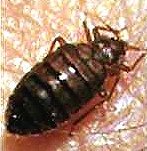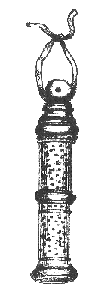Pest Control Tactics
 The history of pest control probably began with the first human who ever swatted a mosquito or picked off a louse. From the fossil record, we know that all major taxa of biting flies and external parasites already existed by the time Homo sapiens first appeared on earth. Phthirus and Pediculus, the two genera of lice that feed on humans, have a host range that is limited to primates (apes and monkeys). And we suspect that human fleas (Pulex irritans) and bed bugs (Cimex lectularius) adopted cave-dwellers as hosts because these insects are most closely related to other species that live on bats. But since our primitive ancestors were hunters and gatherers, they probably found that insects were more useful as food than they were troublesome as pests. (Even today, people in some primitive cultures eat the lice they pick from one another’s hair). It was probably not until the dawn of organized agriculture, when insects attacked the plants we grew for food, that we first recognized them as a potential threat to our own survival.
The history of pest control probably began with the first human who ever swatted a mosquito or picked off a louse. From the fossil record, we know that all major taxa of biting flies and external parasites already existed by the time Homo sapiens first appeared on earth. Phthirus and Pediculus, the two genera of lice that feed on humans, have a host range that is limited to primates (apes and monkeys). And we suspect that human fleas (Pulex irritans) and bed bugs (Cimex lectularius) adopted cave-dwellers as hosts because these insects are most closely related to other species that live on bats. But since our primitive ancestors were hunters and gatherers, they probably found that insects were more useful as food than they were troublesome as pests. (Even today, people in some primitive cultures eat the lice they pick from one another’s hair). It was probably not until the dawn of organized agriculture, when insects attacked the plants we grew for food, that we first recognized them as a potential threat to our own survival.
 Pest control tactics were mentioned occasionally in writings of the ancient Chinese, Sumerian, and Egyptian scholars. Many of these tactics were embedded in religion or superstition, but a few had real scientific merit. Predatory ants, for example, were used in China as early as 1200 B.C. to protect citrus groves from caterpillars and wood boring beetles. Ropes or bamboo sticks tied between adjacent branches helped the ants move easily from place to place. A passage in Homer’s Iliad (8th century B.C.) describes the use of fire to drive locusts into the sea, and the ancient Egyptians organized long lines of human drovers to repel swarms of invading locusts. Pythagorus, a Greek philosopher and mathematician, was credited with clearing malaria from a Sicilian town during the 6th century B.C. by instructing its residents to drain the marshes. Chemical substances that purportedly killed or repelled insects were in common usage. Many of these were of questionable value, but some worked, and a few are still in use today. Some of the inorganic compounds, such as sulfur and arsenic, have well-established insecticidal activity. And modern science has only recently come to recognize that many plant extracts used by ancient apothecaries (e.g, lemon oil, wormwood, hellebore, fleabane, etc.) do indeed contain compounds with useful activity against insects.
Pest control tactics were mentioned occasionally in writings of the ancient Chinese, Sumerian, and Egyptian scholars. Many of these tactics were embedded in religion or superstition, but a few had real scientific merit. Predatory ants, for example, were used in China as early as 1200 B.C. to protect citrus groves from caterpillars and wood boring beetles. Ropes or bamboo sticks tied between adjacent branches helped the ants move easily from place to place. A passage in Homer’s Iliad (8th century B.C.) describes the use of fire to drive locusts into the sea, and the ancient Egyptians organized long lines of human drovers to repel swarms of invading locusts. Pythagorus, a Greek philosopher and mathematician, was credited with clearing malaria from a Sicilian town during the 6th century B.C. by instructing its residents to drain the marshes. Chemical substances that purportedly killed or repelled insects were in common usage. Many of these were of questionable value, but some worked, and a few are still in use today. Some of the inorganic compounds, such as sulfur and arsenic, have well-established insecticidal activity. And modern science has only recently come to recognize that many plant extracts used by ancient apothecaries (e.g, lemon oil, wormwood, hellebore, fleabane, etc.) do indeed contain compounds with useful activity against insects.
 There was very little progress in pest control during the dark ages. Ignorance and superstition abounded. For what it was worth, St. Bernhard excommunicated the flies of his parish in 1121. In a book entitled “Natural History”, Ferrante Imperato (1599) gave a prescription for eliminating flies from a dwelling:
There was very little progress in pest control during the dark ages. Ignorance and superstition abounded. For what it was worth, St. Bernhard excommunicated the flies of his parish in 1121. In a book entitled “Natural History”, Ferrante Imperato (1599) gave a prescription for eliminating flies from a dwelling:
“… draw the image of a fly … on a copper plate during the second half of the constellation of Pisces … then bury it in the center of your house (during) the first half of the constellation of Taurus.”
 With the Renaissance, people began to view insects less as a punishment from God and more as members of a natural world that could be studied and controlled. A renewed interest developed in insects both as organisms and as pests. More accurate observations of natural history and behavior led to more inventive control practices. Hand labor was used extensively in early pest control, but cultural, physical, and chemical practices also evolved. Franz Ernst Brückmann, a German physician who lived in the early 1700’s, designed the first mechanical traps for various insects. His fly traps consisted of a wooden box baited with a sweet attractant and equipped with a spring-loaded lid. When several flies had settled inside the trap, the lid was snapped shut to trap the flies inside. The volume of the trap was then decreased by sliding the ends of the box together and squashing the flies against their bait. Brückmann also designed flea traps. They were hollow, perforated cylinders, baited with blood or honey, and worn around the neck as a pendant. For a time, these flea traps, crafted from ivory or silver and often ornate in design, were popular fashion accessories worn by the aristocracy of western Europe.
With the Renaissance, people began to view insects less as a punishment from God and more as members of a natural world that could be studied and controlled. A renewed interest developed in insects both as organisms and as pests. More accurate observations of natural history and behavior led to more inventive control practices. Hand labor was used extensively in early pest control, but cultural, physical, and chemical practices also evolved. Franz Ernst Brückmann, a German physician who lived in the early 1700’s, designed the first mechanical traps for various insects. His fly traps consisted of a wooden box baited with a sweet attractant and equipped with a spring-loaded lid. When several flies had settled inside the trap, the lid was snapped shut to trap the flies inside. The volume of the trap was then decreased by sliding the ends of the box together and squashing the flies against their bait. Brückmann also designed flea traps. They were hollow, perforated cylinders, baited with blood or honey, and worn around the neck as a pendant. For a time, these flea traps, crafted from ivory or silver and often ornate in design, were popular fashion accessories worn by the aristocracy of western Europe.
 Since the late 1800’s, entomologists and chemists have made outstanding progress in the technology of pest control. Today’s arsenal of weapons is large and diverse, encompassing legal, cultural, physical, genetic, and biological tactics, in addition to the well-known chemical pesticides. In general, all of these tactics work in at least one of the following ways:
Since the late 1800’s, entomologists and chemists have made outstanding progress in the technology of pest control. Today’s arsenal of weapons is large and diverse, encompassing legal, cultural, physical, genetic, and biological tactics, in addition to the well-known chemical pesticides. In general, all of these tactics work in at least one of the following ways:
- They kill the pest directly — usually by exposing it to lethal substances or unsuitable environmental conditions.
- They reduce the reproductive potential of a pest population — often by modifying its environment (biotic or abiotic) or by restricting its movement.
- They modify the pest’s behavior to make it less troublesome (attract it, repel it, confuse it, exclude it, mislead it).
Most of the control tactics that are commonly used today can be grouped into two broad categories: natural controls and artificial controls. By definition, a natural control may be any environmental factor that keeps a pest population below its economic injury level. Examples might include geographic barriers, cold temperatures, or natural enemies that keep population growth in check. Artificial controls, on the other hand, employ products or processes of human origin to modify a pest’s distribution, behavior or physiology. Fly swatters and insecticides are two obvious examples. But as is often true in biology, there are some control strategies that seem to straddle the line, exhibiting characteristics of both groups or not fitting neatly into either category. In fact, some of our most effective tactics are natural controls that we can improve, enhance, accelerate, or augment by appropriate human intervention.
Next page: Cultural Control

